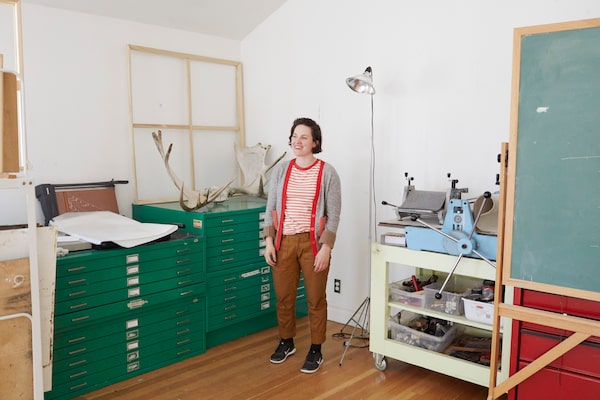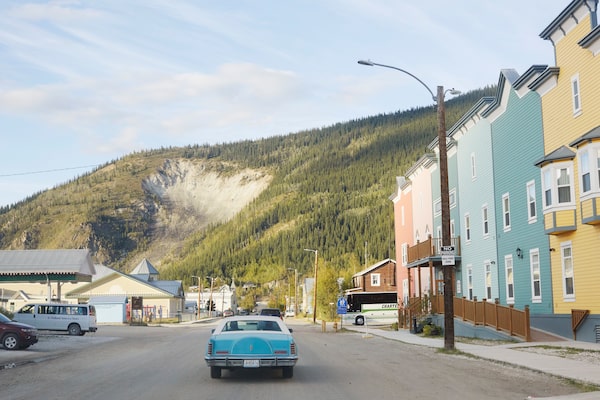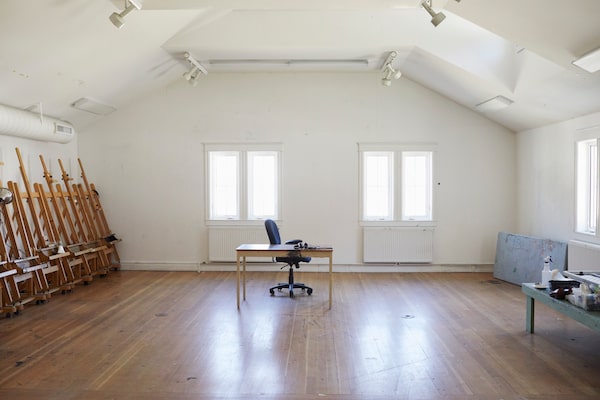
Canada's northernmost fine-arts institution, SOVA, offers up to 20 students a change to study a fully accredited foundation year. But it can be 'hard to find students who want to study in a small town north of 60, where it's going to be minus 50 in the winter,' long-time instructor Veronica Verkley says.Joanne Ratajczak/The Globe and Mail
Big Jody Mufferaw is lying in a makeshift wrestling ring – at the bottom of a packed, natural amphitheatre created by heaps of rocky tailings left over from the Klondike Gold Rush – bleeding. Punk-rock music is blasting, the midnight sun is perched on the horizon, and the crowd, made up of miners, trappers and art students, is hollering for more. “We understood we were supposed to be faking it,” Mufferaw says. “But we didn’t really know how.” That inaugural match in Dawson City, Yukon, she went home with 19 stitches in her thigh.
Mufferaw is Aubyn O’Grady’s wrestling persona, a character she created in 2013 – along with the feminist art collective the League of Lady Wrestlers. And she believes the piece of performance art is a direct result of her education at the Yukon School of Visual Arts (SOVA).
SOVA is Canada’s northernmost fine-arts institution, and it offers up to 20 students a chance to study a fully accredited foundation year in Dawson City. The school, with its unlikely location, has become a place for students to be surrounded by an unlikely cast of characters, and focus on unlikely projects. In the tiny subarctic town of dirt streets, boardwalks and listing Gold Rush-era façades, miners still work the creeks, tourists down Sourtoe Cocktails featuring a real dehydrated digit and madcap characters such as Caveman Bill – who lives year-round in a cave by the river – are welcome.

Aubyn O'Grady, a former student, is the institution's program director.Joanne Ratajczak/The Globe and Mail
For students who end up at SOVA, studying in Dawson remains unforgettable, whether they’re racing sleds made from trash in the school’s Garbage 500, participating in a beach-party flash mob at 40 below, helping a visiting artist cut 10,000 tiny circles of sealskin with a hole punch or wrestling under the midnight sun. O’Grady credits the program with giving her the confidence and creativity to pitch her wrestling piece, which ended up with sister leagues in Quebec, Ontario, Alaska and Georgia.
Lately, though, SOVA has struggled to find students. In 2017, just two applied by its July deadline and Yukon College, which funds and accredits the school, was threatening to shutter it.
“It was heartbreaking,” says O’Grady, who was in Toronto starting a PhD and brawling in a newly formed sister League of Lady Wrestlers when she heard the news. “Across the board, people are not enrolling in visual art any more. They’re more interested in specialized programs, like design, that lead to employment.”
When O’Grady decided to pursue a PhD in education, running SOVA was in her crosshairs. “I was gunning for it, because of how I felt at SOVA as a student,” she says. “How different the experience of being there was, compared to other schools that are run more like businesses.”

Verkley, who left behind a career in Toronto to live in a small cabin north of Dawson, makes animals from detritus.Joanne Ratajczak/The Globe and Mail
So when Yukon College put out a call for new leadership at SOVA last year – offering the floundering art school one more kick at the can – O’Grady threw her name in the hat, even though she didn’t feel ready. During the job interview, O’Grady found herself using confrontations with wrestling rivals to illustrate her management experience. “It was, maybe, a risk hiring me,” says SOVA’s new, 33-year-old program director – tasked with recruiting students and saving the school.
“It’s hard to find students who want to study in a small town north of 60, where it’s going to be minus 50 in the winter and they’re going to see northern lights,” visual artist and long-time SOVA instructor Veronica Verkley says. “It’s a crazy proposition that self-selects pioneering students.”
Verkley, who just showed at Toronto’s Olga Korper Gallery, left behind a burgeoning 20-year career in the city to live in a tiny off-the-grid cabin north of Dawson, where – inspired by the landscape that drew her north, and our impact on it – she makes animals out of detritus: a pack of transparent wolves running through the trees along the Yukon River made from scavenged plastic bags, or a life-size horse stitched together from pieces of scrap leather she managed to hoist on top of one of the town’s dilapidated buildings in an overnight exploit that overjoyed Dawsonites.
The horse now stands outside Verkley’s cabin, covered with snow in winter and leaves in fall. A bear has climbed on top of it, a pair of ravens pulled the stuffing out for their nest, foxes chewed the leather off the legs and bees live in its head. “There are opportunities and experiences here that you’d never have in a big city, like Toronto,” she says.

Since the cost of shipping art supplies can be expensive, SOVA's students find a lot of things at the Dawson dump. Instead of adding to the dump, they are 'borrowing from the waste stream.'Joanne Ratajczak/The Globe and Mail

Metal objects can be used for printmaking after being flattened by a local contractor's steamroller.Joanne Ratajczak/The Globe and Mail
That a fine-arts institution exists this far north, in a town of just more than 1,300, still floors artist David Curtis. When he moved to Dawson in 1998 and discovered the local art society was set on creating an accredited arts school, he thought they were nuts. Nine years later, SOVA opened its doors and its governance council – made up of representatives from Yukon College, the Dawson arts council and the local Tr’ondek Hwech’in First Nation – conscripted Curtis to run it. The school initially targeted students from rural northern communities, offering a transition year before they headed south to bigger cities and colleges. But SOVA ended up not just attracting kids from the North. Curious, intrepid students came from across Canada – and as far away as South Korea.
Alongside more traditional foundation-year arts classes, such as drawing and sculpture, SOVA’s students attended TH101, a crash course in local Tr’ondek Hwech’in history and culture, in which they’re encouraged to connect with Indigenous elders and artists to learn how to tuft moose hair, bead, work with porcupine quills or turn willow bark into paper.
The potential to connect art with the land is one of the things that makes the school so special to people such as Jackie Olson. “I am pushing for even more Indigenous-focused learning opportunities,” the long-time SOVA governance council member and Tr’ondek Hwech’in artist says. “I’m envisioning an Indigenous arts class taught on the land, where you have to take turns making sure there’s a fire and making sure there’s water. Being on the land, listening to the quietness, seeing what’s around you. You don’t do that when you’ve got a cellphone stuck to your face.”
SOVA could, and should, become a real leader linking art practices to environmentalism, Curtis says. “The sheer beauty of this place brings up conceptual ideas of isolation, wilderness and how we encroach on it.”

The school is located in Dawson City, Yukon, a town of just more than 1,300, made up of dirt streets, boardwalks and listing Gold Rush-era façades.Joanne Ratajczak/The Globe and Mail
SOVA’s students spend a lot of time at the Dawson dump – a big gravel yard with a sprawling free store where locals leave unwanted clothes, scrap wood, metal, housewares toys and just about everything else. Verkley takes her classes there to gather materials, sometimes building spontaneous sculptures on site. “Sculpture can be so wasteful,” she says. “You’re experimenting with stuff then throwing it out at the end of the year. This is mitigated by having a dump where you’re borrowing from the waste stream, not adding to it.” It’s also economical in a small northern town, where the cost of shipping in art supplies can be exorbitant. For printmaking, Verkley’s students found metal objects at the dump – big and small – and took them to a local industrial site where the contractor agreed to drive over them with his steamroller. “Then we made prints with these flattened objects,” Verkley says.
“People in Dawson are down with whatever you throw at them,” Yejin Park says. “Even if it’s strange and bizarre.” Park, who just graduated from SOVA and is heading to Vancouver’s Emily Carr University of Art and Design in the fall, came all the way from Seoul to study in Dawson. “I liked the idea of an art school in such an unlikely place,” she says. “How much one-on-one time we got with instructors, how invested the community is in the school and how closely the school works with the Tr’ondek Hwech’in.”
SOVA didn’t disappoint. “At bigger universities the administration is not up to date on how you’re doing personally – at SOVA they’re personally invested.”
Park is now back in Seoul with her noisy cockatoo Percival doing illustration work and moonlighting as a gallery tech. It’s only been a month, and she’s already planning her next trip north.

O'Grady wants to rent studio space to help pad SOVA's overstretched budget, which hasn't increased since the school opened in 2007.Joanne Ratajczak/The Globe and Mail

Joanne Ratajczak/The Globe and Mail
On top of the celebrated artists-in-residence, such as Shary Boyle, Ed Pien, Johannes Zits and Jeneen Frei-Njootli, that O’Grady invites to SOVA each year, she plans to raise the profile of the school by bringing in bachelor of fine art graduates to run master classes in summer – offering them work, teaching experience and possibly grooming them to become future instructors. She wants to rent studio space at the school to help pad SOVA’s overstretched budget, which has not increased since the school opened, and is planning a workshop that would bring more artists from across Canada and the United States. Her biggest focus, though, remains reaching rural students – people like her who wanted to study art, but were pushed away from pursuing it in high school because it didn’t offer a traditional career path. “Now I’m an artist running a school,” she says. “So what am I going to do?”
O’Grady has SOVA alumni across the country, and around the world, reaching out to nearby high schools, especially rural ones. And this winter, she travelled to the fly-in Gwich’in hamlet of Old Crow way up north of the Arctic Circle, as well as the far-flung Inuvialuit communities of Inuvik and Tuktoyaktuk, with a sound engineer in tow. Instead of setting up a table of recruitment swag, she gave a mini-SOVA lecture to the high-school students on sound art. Then, she got them to make a soundscape, layering recordings of things such as pop rolling out of the machine, bouncing basketballs and lockers slamming. A few months later, an application from Inuvik landed on O’Grady’s desk, as well as applications from as far away as Germany and Ghana – 19 in all.
Bringing all these young people in – especially in winter, when tourism dies down and Dawson gets pretty quiet – strengthens the social fabric of the community, Curtis says. “It’s a way of diversifying the economy, away from the diminishing returns of gold.”

O'Grady is part of the feminist art collective the the League of Lady Wrestlers, with the Thunderdome belt, a part of their 2017 show in Dawson City. O'Grady credits her education at SOVA as playing a role in the league's invention.Joanne Ratajczak/The Globe and Mail
The leaning, pink Westminster Hotel – a notorious watering hole known locally as the Pit – has started renting some of its sloping, threadbare rooms as studio space to art students, who end up creating in the company of chain-smoking regulars who’ve been living there month-to-month for years. The town now hosts a winter arts festival, (S)hiver, created by former SOVA alumni, that sees installations on the frozen Yukon River and open studios at the Pit. And during the Discovery Day weekend, which celebrates the first gold strike in the Klondike, Dawson hosts art exhibits and mud bogs.
“You get these bizarre art installations at the same time as a monster truck called the Horny Toad is driving down the street,” says O’Grady, who did a recent installation herself on vape culture called Clouds, which features video screens of two people communicating by smoke-signal Morse code. An old guy who used to work for the Canadian Rangers saw the piece and started translating – he wanted to know what “LOL” meant.
“I love going to work,” says O’Grady, who keeps a Headmistress Mufferaw nameplate on her desk. “It’s an act of defiance.” Everyone working at SOVA, including the administrators, are practising artists. O’Grady interacts with students daily, and students are invested in the lives of their peers and instructors. “I’d never experienced anything like that,” she says. “The rest of my degree, I felt like I didn’t really matter. Then suddenly, at SOVA, I could be curious about the world and was encouraged to be curious and got a tangible result. That’s the most exciting thing about art, you can be interested in a million different things, connect them somehow in these really interesting ways, then teach people through that.”
A year in, O’Grady’s getting more comfortable with the business of running a school – balancing budgets, making policy decisions.
“But I don’t want to let all these bureaucratic mysteries and budgets stop being weird,” she says. “Because it’s a weird way to think about education.”
Live your best. We have a daily Life & Arts newsletter, providing you with our latest stories on health, travel, food and culture. Sign up today.